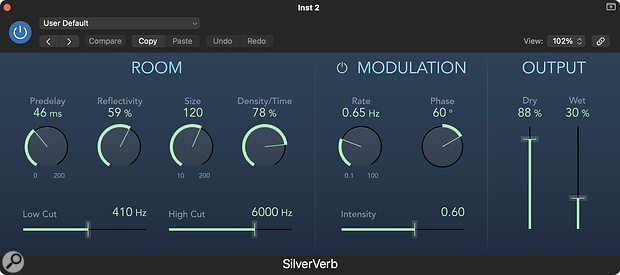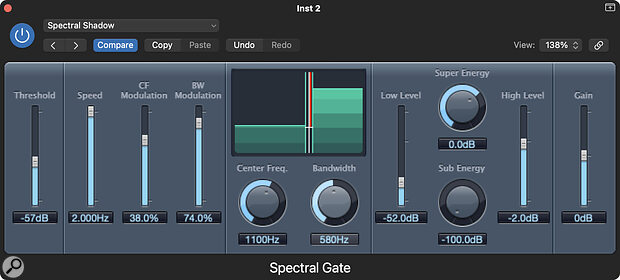 SilverVerb offers a pleasingly retro alternative to Logic’s more obvious reverbs.
SilverVerb offers a pleasingly retro alternative to Logic’s more obvious reverbs.
Behind their basic user interfaces, Logic’s legacy plug‑ins offer some serious sonic magic.
Every day we’re faced with a bewildering choice of third‑party plug‑ins, some costing more than the entire Logic Pro X package. Yet, in many cases, there’s something in Logic Pro that will do the job perfectly well. Typical examples include the compressors, EQs, reverbs and delays, but in this column, I want to shine the spotlight on some of the other included plug‑ins that easily get overlooked, either due to their age or their uninspiring user interfaces.
Silver Surfer
One of my personal favourites in this regard is the humble SilverVerb, a low‑CPU algorithmic reverb that has been part of the Logic plug‑in arsenal for as long as I can remember. It was designed at a time when computers were far less powerful than they are today, and it also has a fairly limited control set. However, its retro and slightly grainy algorithmic texture can sound wonderful on vocals, guitars, synths and so on, and for many of my projects I actually use it in preference to the far more elaborate Chromaverb or Space Designer.
You don’t get a choice of rooms, halls, plates and so on: there’s just one algorithm, called Room. This has a conventional Pre‑delay parameter, but what you won’t find is a traditional reverb Decay control. Instead you have to juggle the Reflectivity, Room Size and Density/Time controls to achieve the length and texture of reverb that you need. There are also basic low‑ and high‑cut filters for shaping the reverb sound. Increasing Reflectivity and Size change the reverb length as well as the apparent size of the space, while turning the Density/Time control anticlockwise reduces the reverb density to the point where it sounds almost like a multi‑tap delay. To the right there’s a useful modulation section; modulation in the left and right channels can be offset using the Phase control. SilverVerb also works very nicely when used together with the Tape Delay plug‑in.
 Spectral Gate can create some interesting modulation effects that you can’t easily achieve otherwise.
Spectral Gate can create some interesting modulation effects that you can’t easily achieve otherwise.
Another charmingly quirky plug‑in is Spectral Gate, which works by dividing the incoming signal into upper and lower frequency ranges that sit either side of a central band. The Center Frequency and Bandwidth parameters control this division. A Threshold control determines at what level the frequency division takes place. The frequencies above and below the defined band can be individually processed using the Low Level and High Level parameter controls, as well as the Super Energy and Sub Energy parameters. Modulation can be applied to the centre band, and if all of this sounds as though the results might be unpredictable, you’d be right. The best bet is just to dive in and see what happens. Adjust the Threshold and at the sweet spot the sound takes on an obviously spectrally filtered, watery quality, with modulation adding an interesting rhythmic element to the effect. The only serious omission I can see is lack of a tempo‑sync option for the modulation, so you have to set the speed by ear. A useful treatment for boring pad parts.
Pedalboard
Those who play keyboards rather than guitar tend to overlook Logic’s guitar amp and pedalboard plug‑ins, but to do so means you miss out on some great tone‑shaping options. Putting a lead or bass synth through a slightly dirty guitar amp can really transform it. The pedalboard is particularly interesting, as it provides alternative takes on some of the standard Logic plug‑ins. For example, the Phaser and Flanger pedals have a few additional controls that allow you to get more creative, and there’s also a passable Uni‑Vibe emulation that you don’t find in the main plug‑in menu. You’ll also find a wide range of overdrive, distortion and fuzz pedals that can work really well with synths, so don’t dismiss this section as being relevant only to guitar players. Note that if you only need a single pedal effect, you can load these individually from the Stompboxes menu rather than having to load the whole virtual pedalboard.
Analogue Action
Logic includes some powerful synths such as Alchemy, the Sculpture modelling synth and the ES2 analogue‑style synth. However, just as was the case with SilverVerb, it is worth looking back at some of the low‑horsepower inclusions for those occasions where they can dish up the sound you need using a small set of intuitive controls. One such is ES Ensemble, a very simple virtual analogue‑style synthesizer with a single oscillator that offers multiple wave shapes. It has basic filter and envelope controls, but at the end of the signal path, it gives you a choice of two chorus types or one ensemble effect. These can be used, usually in conjunction with a sawtooth source waveform, to recreate the sound of old‑school string machines.
 ES Ensemble: a simple but effective virtual analogue synth.
ES Ensemble: a simple but effective virtual analogue synth.
If you haven’t yet tried it, the EVOC 20 Filter Bank is capable of some less obvious effects. Essentially this is a dual filter bank where you can adjust the level of each band fader‑style, change the high and low frequency limits of the filter banks and apply multi‑waveform LFO modulation to the formants to create moving filter effects. The presets give a useful indication of what to expect and for the creation of rhythmic effects, the LFO can be sync’ed to multiples of tempo. There’s also a control for shifting the overall formants of the sound for both filter banks, another for adjusting all the filter resonances, plus an overdrive control to add harmonics. Try the Deep Space preset on a cello part to hear how dramatic the timbral change can be.
 The EVOC 20 Filter Bank plug‑in.
The EVOC 20 Filter Bank plug‑in.
Legacy Instruments & Effects
 To access Logic’s Legacy instruments and effects, hold down the Option key while opening the instrument and plug‑in selection menus.
To access Logic’s Legacy instruments and effects, hold down the Option key while opening the instrument and plug‑in selection menus.
Going even further back in time we need to visit the Legacy plug‑ins section, which only becomes visible if you hold down the Option key before opening the plug‑in selection menu. In the Instruments section you’ll find a list of instruments that have no fancy GUI, just a plain black panel hosting a manageable number of horizontal sliders.
Most of these are simplified versions of the main plug‑in instruments, a good example being the Tonewheel organ. If you find setting up the full‑fat organ plug‑in a bit daunting, you’ll love this version: a single fader labelled Drawbars takes you through a wide range of drawbar combinations, so you just keep moving the slider until you hear a drawbar setting that you like the sound of. The rotary speaker has just two speeds or brake, which you can automate, and there are similarly minimalist controls for distortion and the note percussion level and duration. Super‑simple, but it sounds just as big as its fancy sibling.
 Analog Swirl works a charm on pad and retro string‑synth sounds.Other oldies worth visiting in this section are Analog Swirl, which is great for pads and string‑synth emulations, and Analog Sync, which makes it easy to create those searing phase‑sync lead sounds. Analog Mono delivers passable TB‑303 bass sounds, or simple analogue leads, and its Mix control can usefully crossfade between octaves.
Analog Swirl works a charm on pad and retro string‑synth sounds.Other oldies worth visiting in this section are Analog Swirl, which is great for pads and string‑synth emulations, and Analog Sync, which makes it easy to create those searing phase‑sync lead sounds. Analog Mono delivers passable TB‑303 bass sounds, or simple analogue leads, and its Mix control can usefully crossfade between octaves.
There’s also an instrument called the Digital Stepper, which is dedicated to producing sample & hold‑style filter steps and steps in harmonic content. A Harmonics fader controls the harmonic makeup of the sound, while Balance morphs between an analogue and digital sound character. There is no apparent way to change the stepping rate, and the steps also appear to have a random depth element, which is what creates the sample & hold‑type character. This instrument can go from pad sounds with gentle movement up to full‑on Brain Salad Surgery, and I find myself using it often.
 Digital Stepper’s random nature gives it a distinct sample & hold quality.
Digital Stepper’s random nature gives it a distinct sample & hold quality.
A Verb
Should you visit the Legacy section for insert effects, again accessed by holding down Option before you open the plug‑in menu, you’ll find a reverb called A Verb that is even more minimalist than SilverVerb. This has no modulation, but can still work well on non‑percussive sounds. Personally, I’ve found no reason to delve deeper in the menu than SilverVerb, but there are other early Logic effects such as the Silver Gate, which offers only Threshold, Attack, Hold and Release controls plus variable lookahead. You can’t set the amount of attenuation, but for straightforward hard gating tasks it gets the job done.
You’ll also find the old PlatinumVerb relegated to this section, along with the often criticised spectral Denoiser plug‑in. Now, I’ve never found this noise‑reduction plug‑in to be very effective for actually reducing noise, as it is all too easy to end up with ‘chirpy’ artefacts, but I have discovered that it can sometimes be useful as an effect to add some kind of intentional spectral activity to a boring pad part. Taking the Noise Type fader up above half way produces the most interesting artefacts on typical sound sources.
Plug-in Routings
 The Denoiser plug‑in: not very good at removing noise, but an interesting effect in its own right!Finally, not so much a neglected plug‑in as a neglected feature is the choice of Mono, Stereo or Dual Mono plug‑in routings. Dual Mono mode means that you can process a track to add a stereo effect, but with the ability to set its left and right channel parameters differently. For example, you could have a reverb with different left and right pre‑delays, or one side with a long decay time and the other with a short decay time. Or how about a rotary speaker that runs fast in one channel and slow in the other?
The Denoiser plug‑in: not very good at removing noise, but an interesting effect in its own right!Finally, not so much a neglected plug‑in as a neglected feature is the choice of Mono, Stereo or Dual Mono plug‑in routings. Dual Mono mode means that you can process a track to add a stereo effect, but with the ability to set its left and right channel parameters differently. For example, you could have a reverb with different left and right pre‑delays, or one side with a long decay time and the other with a short decay time. Or how about a rotary speaker that runs fast in one channel and slow in the other?
There’s also a Mono option for most effects. This can be useful when using a reverb as an insert effect, as the panned location of the reverb will always match that of the dry signal, rather than being spread over both channels as is the case when adding a stereo reverb. Many producers use mono reverbs in this way, adding them to individual sources to avoid diluting the stereo image, so it is definitely worth trying next time you come to do a mix.
